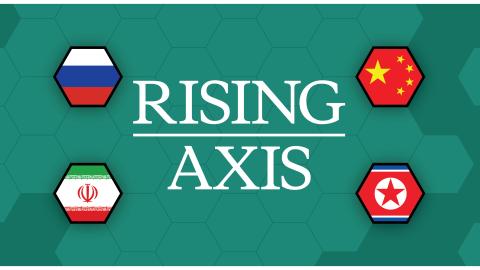Rising Axis showcases the depth of Hudson’s analysis on how America and its allies can compete with and defeat the axis of aggressors.
To receive the newsletter in your inbox, subscribe here.
“Revisionist powers are on the rise and determined to disrupt the global order,” wrote Nadia Schadlow in the Wall Street Journal last fall. For years, Hudson’s experts have traced the interconnections within what Hudson’s H.R. McMaster has called an “axis of aggressors”—a China-led coalition that includes Russia, Iran, and North Korea and seeks to replace the United States–led international system with one more favorable to authoritarianism and tyranny. “China, Russia, Iran, and North Korea want nothing more than to build a world order that they will control,” wrote Hudson President and CEO John Walters following his trip to Ukraine earlier this year.
Bottom Line
“We must realize that all of these threats are working together. Our enemies want to crush us. They see a chance to destroy America. The question is, Will we let them?”
Facts and Figures
1. Russia relies on China, Iran, and North Korea to sustain its war machine.
- The People’s Republic of China provides Russia with 70 to 90 percent of its computer numeric control (CNC) machine tools, which automate the production of precision-guided munitions and aircraft parts, and 90 percent of the microelectronics critical for its production of missiles, tanks, and aircraft.
- Russia receives hundreds of drones from Iran each month and uses them to terrorize Ukrainian civilians. The two autocracies now produce hundreds more drones each month in a jointly operated plant in Russia. And recently, Iran has reportedly begun to provide the Kremlin with tactical ballistic missiles.
- North Korea has provided Russia with millions of artillery shells and numerous types of ballistic missiles.
For more, watch or read Peter Rough’s testimony before the House Foreign Affairs Committee.
2. China supports and encourages military and economic collaboration among authoritarian regimes around the world.
- In 2021, China and Iran signed a 25-year military agreement to advance joint training and exercises, research, and weapons development. Additionally, the PRC has long been the leading market for Iranian oil and has increased its imports in recent years.
- In 2023, Sino-Russian trade reached $240 billion, a 26.3 percent increase over 2022. Oil sales drove much of this increase.
- China is the top destination for both legal and blacklisted North Korean exports, the sales of which fund Pyongyang’s nuclear program.
For more, read Jonathan Ward’s op-ed, “Want a Stable World? Disengage from the Chinese Economy.”
3. America can do more to combat the rise of this axis.
- The US needs to anticipate and capitalize on future geopolitical disruptions in great power competition. This includes leading in evolving technologies like fusion energy and artificial intelligence.
- The Biden administration’s policies to reduce US oil and gas production while tolerating Russian production and exports has given China access to a large supply of discounted energy. Instead, Washington should return to the strong, stable energy policies that made America the primary guarantor of global security and prosperity.
- The US military needs to leverage both established and emerging technologies to deter a Chinese invasion of Taiwan without compromising its ability to project power in other theaters.



















